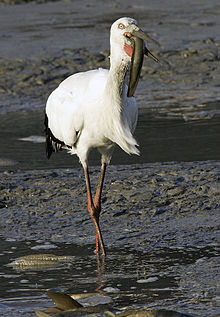- Oriental Stork
-
Oriental Stork 
Conservation status Scientific classification Kingdom: Animalia Phylum: Chordata Class: Aves Order: Ciconiiformes Family: Ciconiidae Genus: Ciconia Species: C. boyciana Binomial name Ciconia boyciana
Swinhoe, 1873The Oriental Stork, Ciconia boyciana, is a large, white bird with black wing feathers. It is closely related and resembles the European White Stork, of which it was formerly often treated as a subspecies. It is typically larger than the White Stork, at 100–129 cm (40–51 in) long, 110–150 cm (43–59 in) tall, a weight of 2.8–5.9 kg (6.2–13 lb) and a wingspan of 2.22 m (7.3 ft).[1][2] Unlike its more widespread cousin, the Oriental Stork has red skin around its eye, with a whitish iris and black bill. Both sexes are similar. The female is slightly smaller than male. The young are white with orange bills.
At one time, the Oriental Stork could be found in Japan, China, Korea and Russia. It is now extinct in Japan and Korean peninsula. However, in May 2007 a hatchling was reported in Japan for the first time in 40 years in the wild. It was offspring of two storks who were bred in captivity.[3] After breeding, the storks migrate to eastern China in September and return in March.
The Oriental Stork is a solitary bird except during the breeding season. Its diets consist mainly of fish, frogs, insects, small birds and reptiles, as well as rodents. The female usually lays between two to six eggs.
The scientific name commemorates Robert Henry Boyce.
Due to habitat loss and overhunting, the Oriental Stork is classified as Endangered on the IUCN Red List of Threatened Species. It is listed on Appendix I of CITES.
See also
- List of Special Places of Scenic Beauty, Special Historic Sites and Special Natural Monuments
References
- BirdLife International (2008). Ciconia boyciana. In: IUCN 2008. IUCN Red List of Threatened Species. Downloaded on 3 February 2009. Database entry includes a range map, a brief justification of why this species is endangered, and the criteria used.
- ^ Hancock & Kushan, Storks, Ibises and Spoonbills of the World. Princeton University Press (1992), ISBN 9780123227300
- ^ CRC Handbook of Avian Body Masses by John B. Dunning Jr. (Editor). CRC Press (1992), ISBN 978-0849342585.
- ^ Endangered white storks hatch egg, Steve Jackson, BBC News, 20 May 2007.
External links
- ARKive - images and movies of the Oriental Stork (Ciconia boyciana)
- BirdLife Species Factsheet
- Red Data Book
- BBC News bulletin about the birth of a chick in Japan
Storks (order: Ciconiiformes • family: Ciconiidae) Genus Mycteria Milky Stork (M. cinerea) • Yellow-billed Stork (M. ibis) • Painted Stork (M. leucocephala) • Wood Stork (M. americana)Anastomus Ciconia Abdim's Stork (C. abdimii) • Woolly-necked Stork (C. episcopus) • Storm's Stork (C. stormi) • Maguari Stork (C. maguari) • Oriental Stork (C. boyciana) • White Stork (C. ciconia) • Black Stork (C. nigra)Ephippiorhynchus Jabiru Leptoptilos 19 living species in six genera Categories:- IUCN Red List endangered species
- Ciconia
- Birds of China
- Birds of Japan
- Birds of Russia
- Special Natural monuments of Japan
Wikimedia Foundation. 2010.

